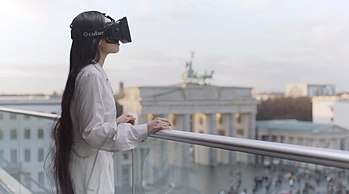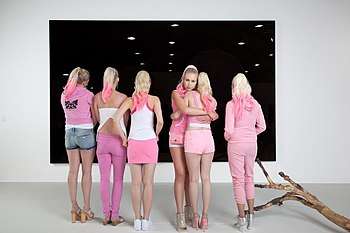DIS (collective)

DIS is a collaborative project based in New York City. It was founded in 2010 by Lauren Boyle, Solomon Chase, Marco Roso, and David Toro, Nick Scholl, Patrik Sandberg, and Samuel Adrian Massey, and publishes DIS Magazine, a twist on a lifestyle and fashion magazine. It is now composed of Lauren Boyle, Solomon Chase, Marco Roso, and David Toro.
The project's title refers to the prefix dis ('to do the opposite of') and is meant to reflect an oppositional attitude.[1] DIS is primarily known for their use of aesthetics as a tool for the subversion of mass-market or corporate culture, and for interdisciplinary overlap between advertising, fashion, communication and popular culture via the Internet. Critics and audiences have associated them with Postinternet art, though they themselves do not identify with the term, dubbing it ‘a pun with no hope for a conceit’ in one interview.
The project began and evolved from an online, interactive magazine that is a twist on a lifestyle, art and fashion magazine.[2] In addition to the magazine, DIS consists of the platforms: DISimages—a project producing new stock imagery–– and DISown, a now closed concept store featuring work by over 30 artists as a laboratory to test the current status of the art object, as well as notions of taste and consumerism.
Projects
_at_the_New_Museum.jpg)
DIS Magazine
DIS Magazine launched in 2010.
The first issue published was the Labor Issue[3], co-edited with artist Chris Kasper. The magazine proposes an horizontal exploration of culture, offering articles on climate change alongside faux-commercials.[4] The content of the online magazine was organized around categories such as distaste, dystopia, discover, and dysmorphia.[5]
Early content was focused on identifying emerging trends and forecasting potential new ones, from accessorizing with nipple clamps through Z-CoiL shoes and Under Armour sports clothing.[1] Explaining their original interest in fashion they have said ‘If there is a temporality that DIS explores, it is mostly imagined. What is more pertinent to this project is the fact that our generation has a blurred point of view on values and on temporality itself. The past, present, and future—or at least a visually skewed representation of them—are immediately accessible by typing a few keywords into an engine. In this way, reality is multivalent, personal, and constantly in flux. The fashion in DIS is not "high" nor "low." It is simply Medium.’[5]

In 2011 they held a Kim Kardashian look-alike contest with MoMA PS1 for at Art Basel Miami Beach.
The Art School issue explored the culture of art school and imagined new art school trends. Architect and artist Alessandro Bava guest edited the Disaster issue, which focused on ecology related topics. The Data Issue took as its starting point the rise of so-called "big data", or more broadly the series of shifts associated with the ubiquitous nature of parallel processing, large data sets, and digital networks.[6]
DISimages
In 2013 DIS established a temporary stock photo studio, DISimages, and invited numerous artists and photographers to participate. DISimages has been described as ‘Shutterstock on ketamine.’ DIS themselves explained that “... stock photographs just perpetuate the same stereotypes over and over again, so we wanted to intercept that and add a few more tags to those weird pictures, to give some more options.”[7]
Artists who contributed to DISimages include Anne de Vries, Ian Cheng, Dora Budor, Maja Cule, Harry Griffin, and Fatima Al-Qadiri.
Shawn Maximo's DISimages project "Confusion is the New Luxury," fused natural landscapes with computer generated images to surreal effect, and Ian Cheng's "3D Models" had virtual human heads reciting commercial programming.[8]
DISown
In 2014 they created a pop-up store called DISown at Red Bull Studios in New York; according to the press release, " 'DISown—Not for Everyone,' is an exhibition posing as a retail store. Or maybe it’s the other way around. As Karl Lagerfeld for H&M is a diffusion line for fashion, DISown is a diffusion line for art.”

For sale were items such as a mobile trash can and office planter by artist Lizzie Fitch, a salad bowl by Hood By Air and a Maje Cule-designed mirrored folding chair intended to "maximize intern productivity."[9]
Describing the art meets commerce aspect of the venture, Christopher Glazek, wrote “DISown”’s upfront commercialism served then to rebuke artists—including some who participated in the show itself—whose market value relies on presenting their work as somehow outside the market system.”[10]
In 2015, they released a line of Political T-Shirts in collaboration with K8 Hardy, Rirkrit Tiravanija, and others. Lauren Boyle described the genesis of the project as such "In our research, we became fascinated with political t-shirt trends, in particular @GOPteens and other right-wing groups," Boyle continued. "Where are the crazy and inspiring progressive t-shirts for our generation? In the grand tradition of commodity activism, we commissioned five artists to design t-shirts that raise awareness. Direct action that's ready-to-wear."[11]
The IXth Berlin Biennale
In 2016, the Berlin Biennale was curated by DIS.
Critical Reception
In a 2012 New York Times article, critic Alex Hawgood wrote that “Not everyone in the fashion world understands DIS Magazine.”[16]
The DIS-curated 9th Berlin Biennale stirred some controversy among critics and audiences. James Farago, of The Guardian, wrote a scathing review, describing the art event as “an ultra-slick, ultra-sarcastic biennial, replete with ads, avatars, custom security guard uniforms, a manic social media presence disposed to hashtags like #BiennaleGlam, and a woman lip syncing to Trap Queen.”
Other critics lauded the Biennale; in the September 2016 Issue of Artforum, British artist Hannah Black wrote that “…They [DIS] have been greeted, just like the modernist avant-gardes were in their time, with accusations of bad politics and even worse taste. Perhaps these critics haven’t noticed: The world is a ruin, but we go on living in it…”
The Biennale has been said to be a benchmark for its original configuration of the artworks and it’s disregard for certain curatorial conventions. According to Douglas Coupland “It marks a distinct fulcrum moment in art history” as older artists were baffled by the exhibition while younger audiences understood it intuitively.
Selected Exhibitions
Frieze Projects
In 2012 DIS received a commission from Frieze Art Fair to present a project at their yearly Regent’s Park event. The result was a series of images using the galleries and architecture of the Frieze London Art Fair as both a backdrop and subject. The series sought to explore new ways of documenting art in an attention economy, a theme in DIS’ work. The curator, Sarah McCrory, said of their work: "They subvert the very language of fashion, art and advertising, right down to making ugly a compliment.”[17]
New Museum Triennial
For the 2015 New Museum Triennial, Surround Audience, curated by Lauren Cornell and Ryan Trecartin, DIS produced The Island (KEN), a hybrid kitchen and bath, in collaboration with Dornbracht and co-designed by high end German design studio Meire and Meire. Special “Whet Talks” were held at The Island, as well as regular ‘shower performances’ in which models would demonstrate how The Island was functional by taking showers.
Musée d’Art Moderne de la Ville de Paris
DIS executed the mise en scene for the Musée d'Art Moderne de la Ville de Paris’s October 2015 exhibition ‘Co-Workers, Network as Artist’, curated by Angeline Scherf, Toke Lykkeberg and Jessica Castex. To design the exhibition, DIS was inspired by collective work spaces, shopping malls, and airport transit areas.[18] They also showed The Island (KEN) in a new installation commissioned specifically for the exhibition.
MoMA
In 2015, MoMA commissioned DIS to create new work for their 30th bi-annual New Photography exhibition, this time titled Ocean of Images and promising to probing the effects of an image-based post-Internet reality.[19] They were also invited to produce the advertising campaign for the show, which starred Conchita Wurst, the Austrian singer and drag queen who became famous overnight after winning Eurovision 2014. She is pictured speaking at a podium with teleprompters at her side, eliciting questions about celebrity, identity, and image making.[20] For the first time, DIS turned the MoMA logo into a watermark.
Project Native Informant
In 2016, DIS put on a solo show, Image Life, at Project Native Informant, a London gallery whom they are also represented by.
References
- 1 2 Daryoush, Haj-najafi (August 2011). "Zine Creamers: DIS Magazine". VICE.
- ↑ "DIS Magazine". DIS magazine. Retrieved July 13, 2017.
- ↑ "DIS Magazine: The Labor Issue".
- ↑ Reichert, Kolja (13 June 2016). "Das digitale Erhabene (The Digital Sublime)". Frankfurter Allgemeine Zeitung.
- 1 2 Gaboury, Jacob (24 March 2010). "Interview with DIS". Rhizome.
- ↑ Pepi, Mike (3 May 2015). "The Dis Data Issue". DIS (Web).
- ↑ Steryl, von Falkenhausen, Hito, Susanne (25 October 2015). "Roundtable: History in a Time of Hypercirculation". Spike Art Magazine.
- ↑ Akel, Joseph (25 February 2013). "Taking Stock with DIS". Interview Magazine.
- ↑ Santopinto, Ana (29 October 2015). "DISown Blows Away the Boundaries Between Art and Commerce". PAPERMAG.
- ↑ Glazek, Christopher (12 June 2014). "Christopher Glazek on Generation DIS". Artforum.
- ↑ Beach, Hana (16 July 2015). "Dis Magazine's New T-shirts Let You Wear the Change You Want to See in the World". I-D Vice.
- ↑ Russeth, Andrew (September 24, 2015). "DIS will curate the 2016 Berlin Biennale". ARTnews.
- ↑ "Berlin Biennale: DIS im Interview. 'Die Stadt ist internationaler geworden'", Monopol, November 24, 2015 (in German).
- ↑ Dorian Batycka, "The 9th Berlin Biennale: A Vast Obsolescent Pageant of Irrelevance", Hyperallergic, June 24, 2016.
- ↑ Jason Farago, "Welcome to the LOLhouse: how Berlin's Biennale became a slick, sarcastic joke", The Guardian, June 13, 2016.
- ↑ Hagwood, Alex (November 16, 2012). "Seriously Unserious About Fashion". The New York Times.
- ↑ Lhooq, Michelle (5 February 2013). "DIS Magazine’s Website of “Subversive” Stock Photography Is Like Shutterstock on Ketamine". Hyperallergic.
- ↑ La, Nouvelle. "CO-WORKERS". Musée D'Art Moderne De La Ville De Paris.
- ↑ "Ocean of Images: New Photography". The Museum of Modern Art. MoMA.
- ↑ Yotka, Steff (6 November 2015). "Conchita Wurst Stars in MoMA Photography Ads by DIS". Vogue.
Further reading
- Jacob Gaboury. "Interview with DIS". Rhizome, March 24, 2010.
- Christopher Glazek, “Shopkeepers of the World Unite”. Artforum, June 12, 2014.
- Kevin McGarry. "Open Up: The Mutating Activities of DIS". Profile. frieze 154, March 14, 2013.